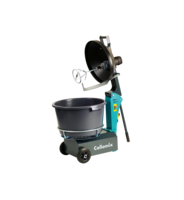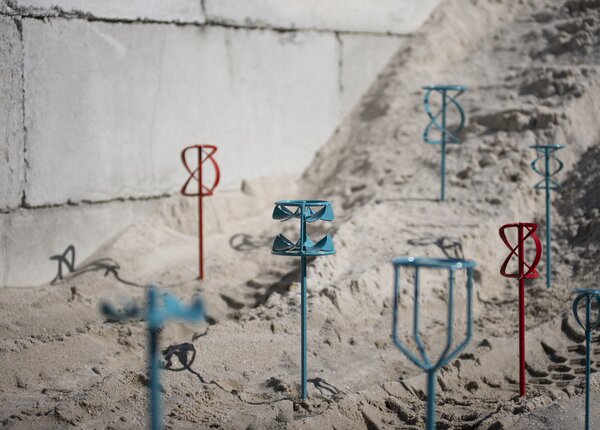
AOX-S - Grout mixer
Installation of large format tiles
Mixing tile adhesive in large quantities with AOX-S
Large format tile installation continues to be a major challenge for tilers. A considered approach and practical experience are basic prerequisites for successful results. Gottschalk, the tiling company from Muehlhausen in Bavaria, has gained a wealth of experience and reputation in large-format tiling in recent years and now works for many discerning customers who demand the highest standards when it comes to implementation and quality.
1000 square meters (approx. 3000 sqft) of surface and tiles in size 320x160 cm (126“x63“)
In this particular case, the task was to tile a showroom with a total hall area of almost 1,000 square metres using tiles in 320 x 160 cm format (126“x63“). Neolith porcelain with a thickness of 12 mm (0.5“) was chosen as the covering material. The surface of these homogeneously sintered tiles is characterised by special strength, scratch resistance as well as bending resistance. With regard to the tile adhesive to be used, the task was to ensure it had a strength of an S-2 type adhesive and, at the same time, would dry relatively quickly. In addition, the intention was to work with an extremely narrow joint width of 2 millimetres (0.08“). Gottschalk was able to rely on the individual technical consultation provided by material manufacturer Schönox, who recommended a cement-based tile adhesive with a specially adapted mixing liquid that would ensure a crystalline setting of the adhesive under the tile and still fulfil S-2 properties.

Rotary mixer AOX-S with paddle KR

Adhesive application on the surface
Mixing as if by magic - with the Collomix AOX-S
For the mixing technology, tiler Gottschalk put its trust in Collomix’s machines. A paddle-mixer from the Xo-R model range was used to pre-mix the two components of the mixing liquid. The AOX-S automatic rotation mixer was used to mix the pasty tile adhesive. This mixer operates with a higher speed of the KR mixing tool used, which – in the case of powdery materials – optimally ensures that the powder is broken down with the water. It was therefore possible to keep labour costs low during the mixing process, as the mixer operates independently and has an exchangeable mixing bucket. With a total adhesive quantity of over 7 tons of material, or close to 200 mixes for the entire surface, automatic mixing certainly paid off. Another factor in favour of using the machine was, of course, the quality of the adhesive to be mixed. Here, one mixture was just like the other – a perfectly workable, smooth adhesive without any lumps. Around 35 kg (77 lbs.) of tile adhesive was needed to lay one tile. A trolley was used to transport the ready-mixed material, with the trolley picking up the 65 litre (17 gal.) bucket from the machine. Given the number of mixes and the size of the hall, the distances covered added up quite considerably and staff had to use their strength as sparingly as possible. In order to compensate for minor unevenness, the floor was laid using the buttering-floating method. The subfloor of the hall was also installed with great care by the previous trade which meant that the necessary height compensation was in a range of only a few millimetres. This could be compensated within a range of 5 - 10 mm (0.2“ - 0.4“) by using different serrations when applying the adhesive.
What makes laying tiles of this size really challenging is, of course, the transport and insertion of the tiles in the adhesive bed. For this purpose, Gottschalk developed its own transport and lifting system, which was used to move the 180 kilo tiles (397 lbs). With the aid of this construction, the tiles could be transported safely and fitted with millimetre precision. After all, a broken tile can have an extremely adverse effect on the calculation. In addition, only a joint width of 2 mm (0.08“) was planned for this design.
All in all, the 5 tiling pros impressively demonstrated their professional skills here and the expert and careful performance of the work once again ensure a satisfied client.

Application of adhesive on the rear side of the tile

Quick and easy transport with the bucket dolly

AOX-S mixing effect with paddle KR




